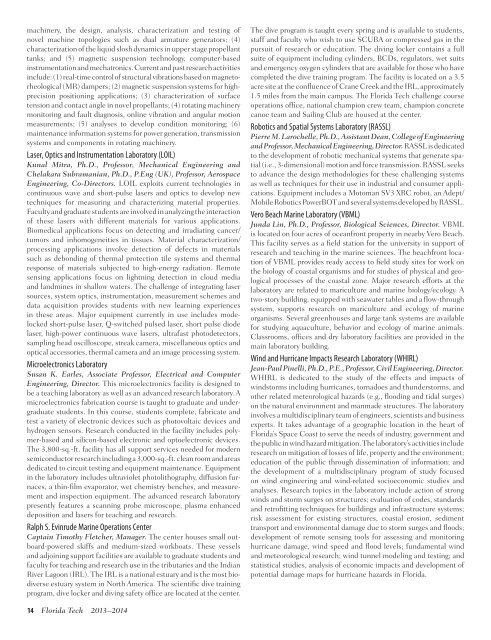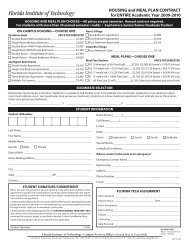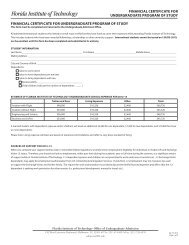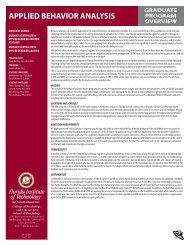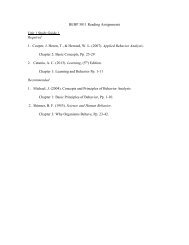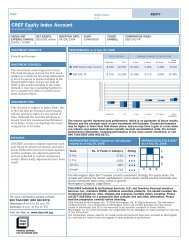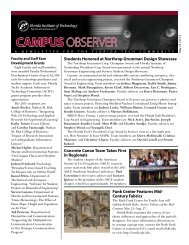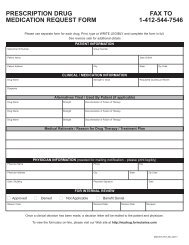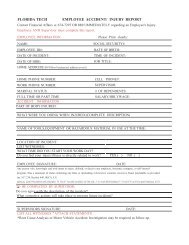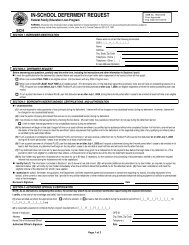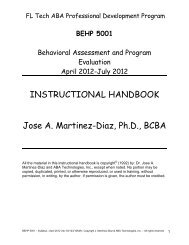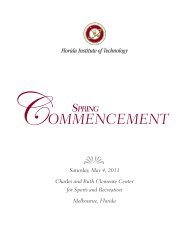2013–2014 UNIVERSITY CATALOG - Florida Institute of Technology
2013–2014 UNIVERSITY CATALOG - Florida Institute of Technology
2013–2014 UNIVERSITY CATALOG - Florida Institute of Technology
You also want an ePaper? Increase the reach of your titles
YUMPU automatically turns print PDFs into web optimized ePapers that Google loves.
machinery, the design, analysis, characterization and testing <strong>of</strong><br />
novel machine topologies such as dual armature generators; (4)<br />
characterization <strong>of</strong> the liquid slosh dynamics in upper stage propellant<br />
tanks; and (5) magnetic suspension technology, computer-based<br />
instrumentation and mechatronics. Current and past research activities<br />
include: (1) real-time control <strong>of</strong> structural vibrations based on magnetorheological<br />
(MR) dampers; (2) magnetic suspension systems for highprecision<br />
positioning applications; (3) characterization <strong>of</strong> surface<br />
tension and contact angle in novel propellants; (4) rotating machinery<br />
monitoring and fault diagnosis, online vibration and angular motion<br />
measurements; (5) analyses to develop condition monitoring; (6)<br />
maintenance information systems for power generation, transmission<br />
systems and components in rotating machinery.<br />
Laser, Optics and Instrumentation Laboratory (LOIL)<br />
Kunal Mitra, Ph.D., Pr<strong>of</strong>essor, Mechanical Engineering and<br />
Chelakara Subramanian, Ph.D., P.Eng (UK), Pr<strong>of</strong>essor, Aerospace<br />
Engineering, Co-Directors. LOIL exploits current technologies in<br />
continuous wave and short-pulse lasers and optics to develop new<br />
techniques for measuring and characterizing material properties.<br />
Faculty and graduate students are involved in analyzing the interaction<br />
<strong>of</strong> these lasers with different materials for various applications.<br />
Biomedical applications focus on detecting and irradiating cancer/<br />
tumors and inhomogeneities in tissues. Material characterization/<br />
processing applications involve detection <strong>of</strong> defects in materials<br />
such as debonding <strong>of</strong> thermal protection tile systems and thermal<br />
response <strong>of</strong> materials subjected to high-energy radiation. Remote<br />
sensing applications focus on lightning detection in cloud media<br />
and landmines in shallow waters. The challenge <strong>of</strong> integrating laser<br />
sources, system optics, instrumentation, measurement schemes and<br />
data acquisition provides students with new learning experiences<br />
in these areas. Major equipment currently in use includes modelocked<br />
short-pulse laser, Q-switched pulsed laser, short pulse diode<br />
laser, high-power continuous wave lasers, ultrafast photodetectors,<br />
sampling head oscilloscope, streak camera, miscellaneous optics and<br />
optical accessories, thermal camera and an image processing system.<br />
Microelectronics Laboratory<br />
Susan K. Earles, Associate Pr<strong>of</strong>essor, Electrical and Computer<br />
Engineering, Director. This microelectronics facility is designed to<br />
be a teaching laboratory as well as an advanced research laboratory. A<br />
microelectronics fabrication course is taught to graduate and undergraduate<br />
students. In this course, students complete, fabricate and<br />
test a variety <strong>of</strong> electronic devices such as photovoltaic devices and<br />
hydrogen sensors. Research conducted in the facility includes polymer-based<br />
and silicon-based electronic and optoelectronic devices.<br />
The 3,800-sq.-ft. facility has all support services needed for modern<br />
semiconductor research including a 3,000-sq.-ft. clean room and areas<br />
dedicated to circuit testing and equipment maintenance. Equipment<br />
in the laboratory includes ultraviolet photolithography, diffusion furnaces,<br />
a thin-film evaporator, wet chemistry benches, and measurement<br />
and inspection equipment. The advanced research laboratory<br />
presently features a scanning probe microscope, plasma enhanced<br />
deposition and lasers for teaching and research.<br />
Ralph S. Evinrude Marine Operations Center<br />
Captain Timothy Fletcher, Manager. The center houses small outboard-powered<br />
skiffs and medium-sized workboats. These vessels<br />
and adjoining support facilities are available to graduate students and<br />
faculty for teaching and research use in the tributaries and the Indian<br />
River Lagoon (IRL). The IRL is a national estuary and is the most biodiverse<br />
estuary system in North America. The scientific dive training<br />
program, dive locker and diving safety <strong>of</strong>fice are located at the center.<br />
14 <strong>Florida</strong> Tech <strong>2013–2014</strong><br />
The dive program is taught every spring and is available to students,<br />
staff and faculty who wish to use SCUBA or compressed gas in the<br />
pursuit <strong>of</strong> research or education. The diving locker contains a full<br />
suite <strong>of</strong> equipment including cylinders, BCDs, regulators, wet suits<br />
and emergency oxygen cylinders that are available for those who have<br />
completed the dive training program. The facility is located on a 3.5<br />
acre site at the confluence <strong>of</strong> Crane Creek and the IRL, approximately<br />
1.5 miles from the main campus. The <strong>Florida</strong> Tech challenge course<br />
operations <strong>of</strong>fice, national champion crew team, champion concrete<br />
canoe team and Sailing Club are housed at the center.<br />
Robotics and Spatial Systems Laboratory (RASSL)<br />
Pierre M. Larochelle, Ph.D., Assistant Dean, College <strong>of</strong> Engineering<br />
and Pr<strong>of</strong>essor, Mechanical Engineering, Director. RASSL is dedicated<br />
to the development <strong>of</strong> robotic mechanical systems that generate spatial<br />
(i.e., 3-dimensional) motion and force transmission. RASSL seeks<br />
to advance the design methodologies for these challenging systems<br />
as well as techniques for their use in industrial and consumer applications.<br />
Equipment includes a Motoman SV3 XRC robot, an Adept/<br />
Mobile Robotics PowerBOT and several systems developed by RASSL.<br />
Vero Beach Marine Laboratory (VBML)<br />
Junda Lin, Ph.D., Pr<strong>of</strong>essor, Biological Sciences, Director. VBML<br />
is located on four acres <strong>of</strong> oceanfront property in nearby Vero Beach.<br />
This facility serves as a field station for the university in support <strong>of</strong><br />
research and teaching in the marine sciences. The beachfront location<br />
<strong>of</strong> VBML provides ready access to field study sites for work on<br />
the biology <strong>of</strong> coastal organisms and for studies <strong>of</strong> physical and geological<br />
processes <strong>of</strong> the coastal zone. Major research efforts at the<br />
laboratory are related to mariculture and marine biology/ecology. A<br />
two-story building, equipped with seawater tables and a flow-through<br />
system, supports research on mariculture and ecology <strong>of</strong> marine<br />
organisms. Several greenhouses and large tank systems are available<br />
for studying aquaculture, behavior and ecology <strong>of</strong> marine animals.<br />
Classrooms, <strong>of</strong>fices and dry laboratory facilities are provided in the<br />
main laboratory building.<br />
Wind and Hurricane Impacts Research Laboratory (WHIRL)<br />
Jean-Paul Pinelli, Ph.D., P.E., Pr<strong>of</strong>essor, Civil Engineering, Director.<br />
WHIRL is dedicated to the study <strong>of</strong> the effects and impacts <strong>of</strong><br />
windstorms including hurricanes, tornadoes and thunderstorms, and<br />
other related meteorological hazards (e.g., flooding and tidal surges)<br />
on the natural environment and manmade structures. The laboratory<br />
involves a multidisciplinary team <strong>of</strong> engineers, scientists and business<br />
experts. It takes advantage <strong>of</strong> a geographic location in the heart <strong>of</strong><br />
<strong>Florida</strong>’s Space Coast to serve the needs <strong>of</strong> industry, government and<br />
the public in wind hazard mitigation. The laboratory’s activities include<br />
research on mitigation <strong>of</strong> losses <strong>of</strong> life, property and the environment;<br />
education <strong>of</strong> the public through dissemination <strong>of</strong> information; and<br />
the development <strong>of</strong> a multidisciplinary program <strong>of</strong> study focused<br />
on wind engineering and wind-related socioeconomic studies and<br />
analyses. Research topics in the laboratory include action <strong>of</strong> strong<br />
winds and storm surges on structures; evaluation <strong>of</strong> codes, standards<br />
and retr<strong>of</strong>itting techniques for buildings and infrastructure systems;<br />
risk assessment for existing structures, coastal erosion, sediment<br />
transport and environmental damage due to storm surges and floods;<br />
development <strong>of</strong> remote sensing tools for assessing and monitoring<br />
hurricane damage, wind speed and flood levels; fundamental wind<br />
and meteorological research; wind tunnel modeling and testing; and<br />
statistical studies, analysis <strong>of</strong> economic impacts and development <strong>of</strong><br />
potential damage maps for hurricane hazards in <strong>Florida</strong>.


